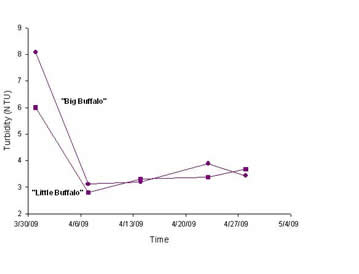Water Chemistry in Two Vernal Pools |
||||||
|
||||||
| Chlorophyll-a in the surface water was very similar in the two ponds except for one date in mid April. Levels of chlorophyll-a varied from less than 3 ppb to almost 9 ppb in Big Buff Pond. |
||||||
| Initial phycocyanin fluorescence, a proxy measure of cyanobacteria, was highest in Little Buff Pond, and generally increased through the season to roughly 9,000 Microcystis cell equivalents ml-1 in both ponds. |
||||||
Both ponds exhibited a rapid decrease in the concentration of dissolved oxygen (DO) in the upper water. Immediately after ice-out DO levels were near saturation (8.7-9.4 ppm in Big Buff and Little Buff, respectively, on March 31) and a month later (April 28) had declined to 3.9 to 4.5 ppm in Big and Little Buff ponds, respectively. |
||||||
| Both ponds were alkaline during the first month (8.8 and 8.1 in Big and Little Buff Ponds, respecitively) and declined with time to 8.0 and 6.7, respectively, by April 28. These high pH values are somewhat surprising, considering the conspicuous brown staining from the humic acids in both ponds. |
||||||
| Specific conductance, a measure of the salt concentration, was consistently higher in Big Buff Pond and more than double that of Little Buff Pond on the first day of observation (314 vs 121 µS). Specific conductance increased with time in both ponds to 389 and 231 µS, respectively. Salt concentrations in these vernal ponds was considerably higher than would be expected in unpolluted New Hampshire lakes, which generally range from 30 to 150 µS. |
||||||
|
| ||||||











